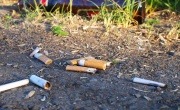Waste of space
The waste is out there. With man’s race to space now raining its junk down on us, Will Simpson asks whether it’s time waste management went intergalactic
The disposal of waste isn’t just a problem on earth. Though we spend a great deal of time collecting it, recycling it and shovelling it into landfill on this planet, it turns out there’s more of a problem circling above our heads. And, no, it’s not your typical earthly rubbish of food waste, packaging and bin bags, but the cosmic detritus that is a by-product not just of the space race, but of man’s increasing reliance on technology. This ‘space junk’ is fast becoming an unavoidable issue that could have major repercussions on our continued presence in space.

With remarkable aptness, whilst this article was being written, NASA’s six tonne UARS (Upper Atmosphere Research Satellite) hit the headlines when it dropped to earth in the North Pacific. And ROSAT, a German satellite, crashed down in October over the Bay of Bengal. But it’s not satellites crashing to earth that are the main problem, but the thousands of items that remain in orbit and could potentially collide with each other, or with working spacecraft. A recent report by the National Research Council in the US suggested that the problem ‘has reached a tipping point’ that could seriously compromise the crucial work of satellites and, by extension, human technology on earth.
The problem of space junk was first identified by NASA scientist Donald Kessler as far back as 1978. Writing in the Journal of Geophysical Research, Kessler postulated that as the number of artificial satellites launched into space increased, so would the possibility of collisions between them. These collisions would create fragments that would then also go into orbit themselves, further increasing the possibility of collisions, and so on. Before long, he argued, a belt of artificial debris would be orbiting the earth.
More than three decades on, Kessler’s predictions have proved to be alarmingly accurate. Some estimates calculate that there are tens of millions of bits of space junk – mostly consisting of pieces of dismantled spacecraft and rocket boosters – now orbiting us, with 22,000 bits large enough to be tracked from earth. And collisions have already started: in 2007, China tested an anti-satellite weapon on one of its decommissioned weather satellites, smashing the object into 150,000 pieces larger than one centimetre. This intentional obliteration was followed by an accidental crash two years later, when two satellites (one working, the other defunct) crashed in orbit, creating even more debris. And then, this June, the International Space Station narrowly missed being hit by another piece of space junk – six crewmembers had even climbed into their escape capsules in anticipation of an emergency evacuation to earth.
Though much of the debris is tiny – less than a few centimetres in diameter – because of the high speeds at which the bits travel (tens of thousands of miles per hour) they present a problem that must be faced sooner rather than later. That’s the verdict of Professor Richard Crowther, Space Security Expert at the UK Space Agency. “It’s a serious problem for any country that uses space, which includes most of the world. Not so much because of the danger of the debris coming down to earth – though that does exist – but because of the consequences possible collisions might have on our future use of space.
“We rely on satellite technology for navigation, research, weather reporting and timing; GPS systems are dependent on it. If space debris increases exponentially then there might be more collisions between existing craft and it will become more difficult to launch new satellites.”
Most space debris consists of aluminium and titanium, as well as propellant that is used in fuel tanks, which usually consists of hydrogen and hydrazine. Unfortunately, even if we were to get this down to earth successfully, very little of this could be reused. “Some titanium could be reused in space because it is very robust”, says Crowther. “But because we’re talking about small amounts it is unlikely that any of it could ever be recycled back down on earth. It would be too expensive and not really worth pursuing.”
So what is being done to clean up this cosmic mess? There are a number of systems that are being developed around the world that aim to tackle the problem without making it worse. One of these is headed by Italian Space Agency researcher Marco Castronuovo. The concept is to launch a satellite carrying a number of de-orbiting devices including solid propellant kits. The craft would rendezvous with larger pieces of space junk and attach a de-orbiting device to them by means of a robotic arm. The device would be activated when the craft was a safe enough distant away, and a robotic arm would hurl the objects out of orbit.
Castronuovo’s paper, which was published earlier this year in the journal Acta Astronautica, concludes that such a scheme would be technically feasible. The downside is that the craft would only be capable of de-orbiting five to 10 large objects per year. On its own, it is unlikely to make much of a dent in the earth’s everdensifying cloud of space junk.
Meanwhile in Guildford, The University of Surrey’s Space Centre has come up with another possible solution, a device called the Cube Sail. This is a compact spacecraft with a mass of around three kilogrammes and dimensions of just 10 by 10 by 30 centimetres. “It’s based on four metal tape booms which are coiled”, explains Senior Lecturer at the university Vaios Lappas. “When those booms are deployed you have a very thin membrane, which is essentially used as a sail. We point the spacecraft in the velocity direction, thereby increasing the frontal area from 10 by 10 centimetres to 25 square metres, and that impacts at the velocity of the spacecraft. But because you have drag you cause the spacecraft to decelerate and therefore reduce its altitude.”
Essentially (more in laymen’s terms, that is), the Cube Sail drags pieces of junk out of orbit (de-orbits them) without propulsion. What happens next depends on the size and mass of the debris. If the piece of junk is very large or at a high orbit it could take hundreds of years before it is attracted once more to the earth’s atmosphere. Pieces that are smaller and closer to the earth may of course enter the earth’s orbit again far more quickly. Some space debris may also eventually explode if it contains propellant with thermal gradients.
Surrey Space Centre is currently building the prototype of the Cube Sail and Lappas claims that they will be ready to launch next year. They are currently looking for sponsorship for the launch, from either private donors or the UK government.
Indeed there is an inescapable political dimension to the problem of space junk. Any concerted effort to deal with it will take international cooperation. But the original space race was predicated upon the competition and mutual suspicion that characterised Cold War politics, and much of this still lingers today. Will the Chinese government allow an American mission to clear up the debris of its old satellites? Or vice versa?
“This is one of the big debates”, explains Lappas. “The United Nations have put forward a 25-year de-orbit recommendation, but the important bit is how we go about enforcing this. At the moment some space agencies, like the European Space Agency are taking this very seriously. In France they’ve made it law where if you put a spacecraft into space you need to de-orbit it within 25 years.
“So there are a variety of institutional responses to this. Some countries are moving faster than others. It’s still very much uncoordinated.” He suggests that the only way forward is an international treaty that is signed by all the nations that have used satellites.
Until then expect more incidents like UARS and the space station scare. Thankfully NASA’s old weather satellite crashed down without harming human life. Next time we might not be so lucky.




